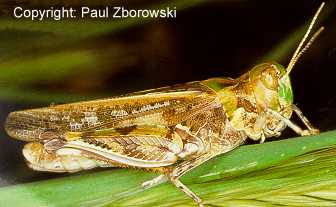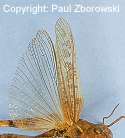Adult description 4 of 15


Size: Females 25 to 35 mm, males 15 to 25 mm
Adult Description: Colour can vary from brown to greenish in both sexes and during swarming, the males can be bright yellow. In profile the head is raised above the saddle shaped thorax. The top of the thorax has a faint 'X' mark, with the rear half more prominent. The rear of the thorax is wider than the head. The rear leg femur has two distinctive dark triangles and the tibia colour varies from pale straw to pink and orange but as red as in the Australian plague locust. Hind wing is clear with a dark margin on the forward edge only. Throat peg absent.
Confusion with Australian plague locust: Very similar shape and behaviour, including that of swarming (compare photos).
Unique features: The combination of distinctive triangles on the rear femur, with the dark forward edge of the hind wings. The size is usually smaller than that of the Australian plague locust in the same area and the tibia are not red. Some other species of Austroicetes have the dark forward edge on the hind wing but most do not have the thorax as wide at the rear. Only A. cruciata has a yellow swarm phase.
Further information on this species: Description of nymph
